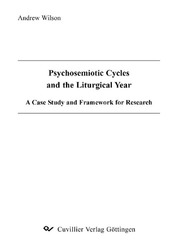| Departments | |
|---|---|
| Book Series (96) |
1378
|
| Nachhaltigkeit |
3
|
| Gesundheitswesen |
1
|
| Humanities |
2363
|
| Medienwissenschaften | 16 |
| Theology | 57 |
| Philosophy | 102 |
| Law | 422 |
| Economics | 850 |
| Social sciences | 416 |
| Sports science | 48 |
| Psychology | 233 |
| Educational science | 190 |
| History | 182 |
| Art | 110 |
| Cultural studies | 166 |
| Literary studies | 116 |
| Linguistics | 88 |
| Natural Sciences |
5406
|
| Engineering |
1791
|
| Common |
98
|
|
Leitlinien Unfallchirurgie
5. Auflage bestellen |
|
Advanced Search
Psychosemiotic Cycles and the Liturgical Year (English shop)
Andrew Wilson (Author)Preview
Table of Contents, Datei (49 KB)
Extract, Datei (78 KB)
Psychosemiotic Cycles and the Liturgical Year
This book sketches the outline of a psychosemiotic framework for studying “aesthetic-religious experiences”, both within and beyond the Christian liturgy. Rejecting a simple dichotomy between religious/spiritual/mystical experiences (on the one hand) and aesthetic experiences (on the other), it is argued that they are essentially one and the same, and that any distinction between them consists in their contextualization (or “discernment”) in relation to a body of doctrine – hence the unitary term “aesthetic-religious experience”. It is proposed that such experiences are, in fact, altered states of consciousness, induced by deeply concentrated narrowed attention on a personally meaningful stimulus (or “symbol”) which is perceived as particularly beautiful and pleasurable. Building on this foundation, the book goes on to focus especially on the relationship between aesthetic-religious experiences themselves and conventionalized patterns of narrating them. By means of a detailed case study of the cycle of seasonal prayers in a version of the Anglican Book of Common Prayer, the book shows how Martindale’s methodology of “narrative pattern analysis” – a combination of computer-assisted content analysis and statistical methods for the analysis of time-series data – can be used to explore hypotheses about the psychodynamic relationships between liturgical texts, liturgical and natural time, and the wider Christian tradition of narrating mystical experience. The book’s theoretical foundations represent a practical synthesis of ancient and modern thought, and draw on psychological, semiotic, and aesthetic concepts taken from the (neo-)Thomistic and Franciscan scholastic traditions, the writings of the Canadian Jesuit philosopher Bernard Lonergan, and modern psychoanalysis, psychology, and linguistics.
| ISBN-13 (Printausgabe) | 3867276692 |
| ISBN-13 (Hard Copy) | 9783867276696 |
| ISBN-13 (eBook) | 9783736926691 |
| Language | English |
| Page Number | 134 |
| Edition | 1 Aufl. |
| Volume | 0 |
| Publication Place | Göttingen |
| Publication Date | 2008-08-01 |
| General Categorization | Non-Fiction |
| Departments |
Theology
Psychology Linguistics |
| Keywords | computer-assisted content analysis; liturgy; liturgical year; prayers; Book of Common Prayer; psychology of religion; depth psychology |








